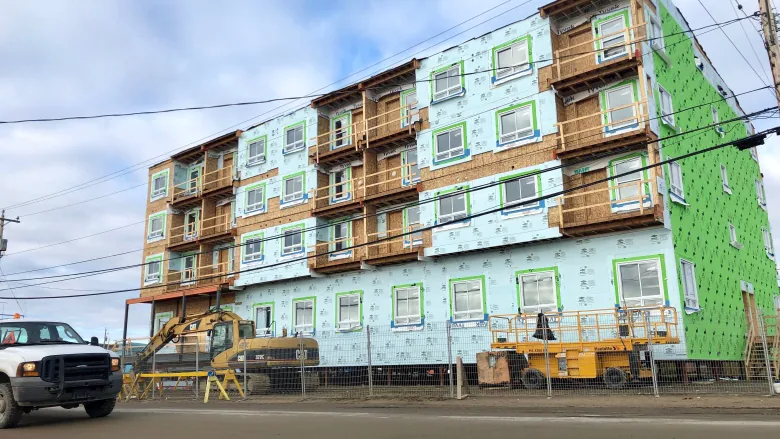COVID-19 worsens housing shortage in northern Canada: CMHC report

National agency’s annual northern housing report studies housing in territories’ capitals
A new report from the Canada Mortgage and Housing Corporation (CMHC) has found that the need for new, affordable and quality housing throughout the territories continues to rise — in part because of the COVID-19 pandemic.
The 2021 Northern Housing report found that while COVID-19 cases were often not as prevalent in Yukon, the Northwest Territories and Nunavut as they were in other parts of Canada, people in the North have nonetheless faced added financial stress because of the pandemic.
Building new homes has also become more expensive because of labour shortages and supply chain disruptions, adding to pre-existing concerns about access to housing in the North.
“The Territories have persistently faced affordability challenges,” the report stated. “This is partly due to the high cost of construction — further exacerbated by the increasing cost of input prices caused by the pandemic.”
As of June 2021, the federal government had invested $821 million to help households in the territories access safe and secure housing as part of the National Housing Strategy.
Northwest Territories
In the Northwest Territories, the report found market rental rates and average home prices have both increased since 2019. While the population in the N.W.T. remained stable, the number of available rental apartments went down, and the total median rent increased by 2.2 per cent.
Over 40 per cent of households in the N.W.T. said their housing was inadequate, unaffordable or unsuitable in some way. Those three criteria are what CMHC defines as “core housing need,” a key criteria for determining how well the available housing is serving people in a given area.
Michael Mak, an analyst with CMHC who worked on the Northwest Territories-focused portion of the report, said seniors were particularly likely to have trouble finding housing.
“With senior populations, [there are] seniors that live alone, seniors that don’t have dual retirement income and, of course, seniors that don’t have any income at all,” he said. “That, combined with retirement, inability to work, disability — all those factors make it so that it is much more difficult for the senior population to come across affordable housing.”
But Mak said all segments of the population are affected by many of the same issues.
“Housing in Yellowknife and the Northwest Territories has really seen supply issues — similar to other territories in the North,” he said. “Housing is expensive. We have large amounts of core housing need … and, of course, we do see that with the current supply, there are a lot of older units that might be too old or in poor condition.”
But Mak said there is some cause for optimism. With dozens of new residences under construction in Yellowknife, renters and homebuyers in the territorial capital may soon have more new options to choose from.
Yukon
The report also found housing affordability to be a serious challenge in Yukon, particularly in Whitehorse, where “market options are out of reach for some households without financial assistance.”
In fact, the report found nearly 20 per cent of all households in Whitehorse could not secure market housing without some form of assistance in 2019.
Young people, seniors and single parents had a particularly difficult time finding adequate, suitable and affordable housing.
But the report also found that new housing construction in Whitehorse had more than doubled in 2020 — to 478 units —from the 230 units started in 2019, well above the five- and 10-year averages for new housing starts in the city.
Nunavut
In Nunavut, continued population growth means a greater need for new housing. Unfortunately, the report found that “new supply has been unable to keep pace.”
In Iqaluit, the vacancy rate for rental homes and apartments has stayed near zero for the third year in a row.
In 2019, nearly 40 per cent of households in Nunavut would have needed assistance to secure market housing.
This is a particularly significant problem for younger households, according ot the report. In the same year, approximately 80 per cent of households with people younger than 25 years old could not find any affordable market housing without help.
Additionally, 36.5 per cent of households in Nunavut reported that their housing was inadequate, unsuitable or unaffordable, the highest level in Canada.
Nearly 90 per cent of these households said their housing was unaffordable, while 69.8 per cent said it was inadequate and 77.8 per cent said it was unsuitable.
Related stories from around the North:
Canada: 18 new modular housing units coming to Tłı̨chǫ region in Canada’s Northwest Territories, CBC News
Finland: Report highlights Finland’s top 5 housing problems, Yle News
Norway: Population declining in Arctic Norway, The Independent Barents Observer
Sweden: Abandoned properties a challenge for rural Sweden, Radio Sweden
United States: Budget cuts threaten transitional housing program in Alaska’s largest city, Alaska Public Media



